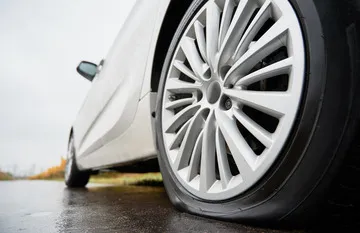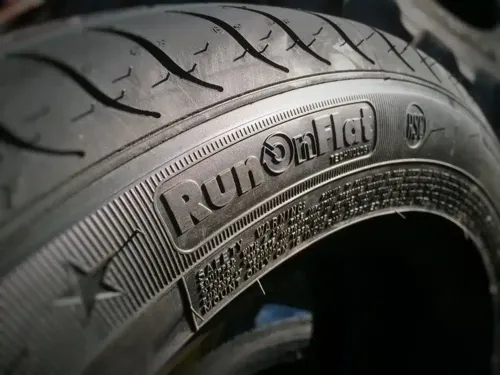How would under inflated tyres affect your vehicle?
Learn why maintaining proper tyre pressure is crucial.
Posted on

Driving with under-inflated tyres might seem like a minor issue, but it can have serious consequences for both your vehicle’s performance and your safety.Tyre pressure affects many aspects of your vehicle, from handling to fuel efficiency, and when tyres are under-inflated, they can compromise the way your car operates.
In this post, we’ll explore how under-inflated tyres can affect your vehicle and why it’s important to maintain the correct tyre pressure.
1. Decreased Fuel Efficiency
One of the most immediate effects of under-inflated tyres is a reduction in fuel efficiency. When your tyres don’t have enough air, they create more rolling resistance with the road. This means your engine has to work harder to keep your vehicle moving, using more fuel in the process.
In fact, studies show that for every 1 PSI drop in tyre pressure, you can lose 0.2% of fuel efficiency. Over time, this adds up, leading to higher costs at the pump.
2. Uneven Tyre Wear
Tyres that are under-inflated wear unevenly, which can lead to the need for more frequent replacements. When tyre pressure is too low, the outer edges of the tyre make more contact with the road than the center. This causes excessive wear on the edges, shortening the lifespan of your tyres.
Not only does this increase your tyre replacement costs, but it also affects the overall performance of your vehicle. Uneven wear can lead to alignment problems and make your vehicle harder to handle.
3. Reduced Vehicle Handling and Control
Under-inflated tyres can significantly impact how your vehicle handles, especially when it comes to steering and braking. Properly inflated tyres allow for optimal contact with the road, giving you better control over your vehicle. When tyres are under-inflated, they become less responsive, which can lead to:
- Poor cornering: Your vehicle may feel sluggish or unsteady when turning.
- Longer stopping distances: Braking performance is reduced, increasing the time it takes to come to a full stop.
- Reduced grip: Low pressure reduces traction, especially in wet conditions, making it more likely for your car to skid or hydroplane.
4. Increased Risk of Tyre Blowouts

Perhaps the most dangerous consequence of under-inflated tyres is the increased risk of a tyre blowout. As tyres lose air, they flex more, causing the rubber to heat up. Excessive heat build-up can weaken the tyre, increasing the chance of a blowout, especially at high speeds.
Blowouts can lead to loss of vehicle control, resulting in accidents, particularly on motorways where vehicles are moving at higher speeds.
5. Damaged Suspension and Alignment
Under-inflated tyres don’t absorb road impacts as well as properly inflated ones, which can cause excessive wear and tear on your vehicle’s suspension system. This can result in premature damage to components like shocks, struts, and ball joints.
Additionally, driving on under-inflated tyres for an extended period can throw your vehicle’s wheel alignment off. Poor alignment leads to uneven tyre wear and affects your vehicle’s handling, creating an even greater need for repairs.
6. Impact on Safety
The most important consequence of under-inflated tyres is the impact on your overall safety. Poor handling, longer stopping distances, and the risk of blowouts all increase the likelihood of accidents. According to tyre safety studies, under-inflated tyres are responsible for a significant number of tyre-related accidents each year.
Maintaining the correct tyre pressure ensures that your vehicle operates safely, particularly in challenging conditions like rain, snow, or ice.
How to Avoid the Risks of Under-Inflated Tyres
Maintaining proper tyre pressure is one of the easiest ways to avoid the issues mentioned above. Here are some tips to help keep your tyres properly inflated:
- Check your tyre pressure monthly: Tyre pressure can fluctuate with changes in temperature, so it’s important to check your tyres regularly.
- Use a quality tyre pressure gauge: Don’t rely on visual checks alone. A tyre can appear properly inflated but still be under-inflated. A pressure gauge gives you an accurate reading.
- Know your vehicle’s recommended tyre pressure: Check your vehicle’s manual or the tyre pressure label inside the driver’s side door for the correct PSI.
- Top up air as needed: If your tyres are under-inflated, top them up at a petrol station or using a home air compressor.
- Check for leaks: If you frequently find your tyres under-inflated, it could be a sign of a slow leak. Have your tyres inspected by a professional.
Final Thoughts
Under-inflated tyres are more than just an inconvenience — they can significantly affect your vehicle’s performance, fuel efficiency, and safety. By regularly checking and maintaining the correct tyre pressure, you’ll not only extend the life of your tyres but also improve your vehicle’s handling and reduce the risk of dangerous blowouts.










